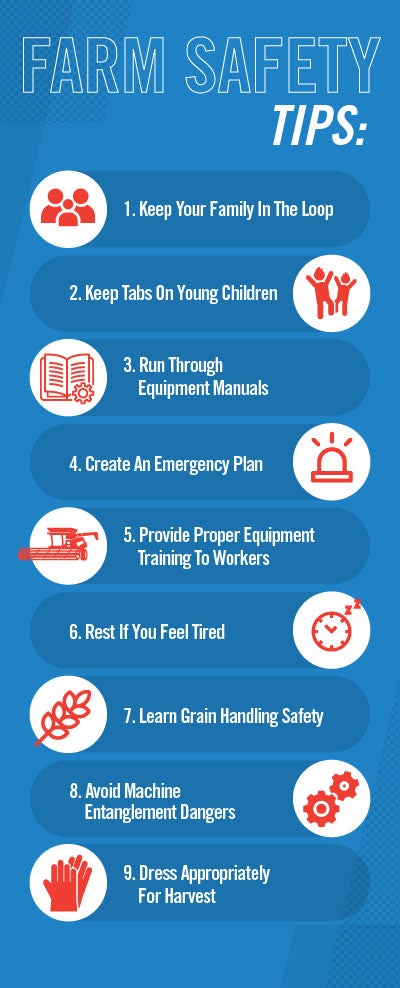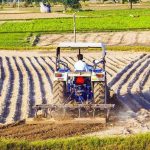Imagine the tranquility of a farm—the fresh air, the open fields, and the freedom for children to explore nature’s playground. But beneath this serene setting lies a world of powerful machinery that demands respect and caution, especially when children are around.
As a parent or guardian, your top priority is to ensure your child’s safety in every environment, and the farm is no exception. This guide will provide you with essential tips and insights to protect your little ones from the potential hazards associated with farm equipment.
By the end of this article, you’ll have the knowledge and peace of mind to confidently keep your children safe while they enjoy the wonders of farm life. Stay with us as we delve into the crucial aspects of farm equipment and child safety, empowering you to create a safe haven for your family.

Common Farm Hazards
Farm equipment poses significant hazards, especially for children. Keep kids away from machinery to ensure their safety. Educate them about potential dangers and establish clear boundaries on the farm.
Farms are bustling with activity and life, but they also pose unique risks, especially for young children. Understanding common farm hazards is crucial for ensuring a safe environment where kids can explore and learn without undue risk. This section will delve into these hazards and offer practical advice on keeping kids safe on the farm.Tractors And Machinery
Tractors and other machinery are a staple on any farm. They’re powerful and essential, but they can be dangerous for children. Always ensure that children stay away from machinery when it’s in use. Have you ever watched a child’s eyes widen at the sight of a tractor? It’s fascinating for them, but safety must come first. Teach your kids to admire from a safe distance.Animal Enclosures
Animals are a big part of farm life, but they can be unpredictable. Keep children away from animal enclosures unless supervised by an adult. Even the friendliest animals can react unexpectedly if startled. Educating kids on how to behave around animals can prevent accidents.Pesticides And Chemicals
Pesticides and other chemicals are common on farms. Store them securely and ensure they are out of reach of children. A locked cabinet or a high shelf can be a simple yet effective solution. Have you considered labeling them clearly to avoid any confusion?Water Hazards
Water bodies like ponds and troughs can be enticing to children but pose drowning risks. Always supervise children closely around water and consider installing barriers if necessary. Have you ever wondered how quickly a child can slip into water unnoticed? Regular checks and vigilance can save lives.Uneven Terrain
Farms often have uneven ground, which can lead to trips and falls. Make sure children wear appropriate footwear and are aware of their surroundings. Think about the last time you stumbled on a rock or hole. Imagine how much more likely it is for a running child to have a mishap. Regularly inspecting and maintaining pathways can minimize risks. Remember, a farm can be a wonderful place for children to grow and learn. With awareness and vigilance, you can ensure their safety while they enjoy the wonders of farm life. Are there other hazards you’ve encountered on your farm? Share your experiences and tips to help others protect their loved ones.
Child-friendly Zones
Creating child-friendly zones on farms is crucial for child safety. These zones help protect children from potential hazards. Farm equipment can be dangerous for young ones. Setting up designated areas ensures they can play safely.
Designing Safe Play Areas
Start by identifying safe spots away from machinery. Choose flat, open spaces with clear boundaries. Ensure these areas have no access to farm equipment. Use fences or natural barriers to define these zones. This prevents accidental wandering into risky areas.
Clear Signage And Boundaries
Install clear signs to mark child-friendly zones. These signs should be visible and easy to understand. Use bright colors and simple symbols. Clearly marked boundaries help children know where they can play. Parents can also easily identify safe spots.
Educational Activities
Include educational activities within these zones. Teach children about farm safety through games and stories. Use fun activities to explain the dangers of farm equipment. This helps children learn and remember safety rules.
Regular Supervision
Ensure regular supervision in child-friendly areas. Adults should monitor children’s activities closely. Supervision reduces risks and maintains safety. Active presence of adults encourages safe behavior among children.
First Aid Preparedness
Keep first aid kits near child-friendly zones. Be prepared for minor injuries or accidents. Educate children on basic first aid. This helps them understand the importance of safety and care.
Equipment Safety Measures
Farm equipment safety is crucial to protect children from potential hazards. Regular checks and proper maintenance reduce risks. Educating kids on safety rules around machinery prevents accidents and ensures a safer farming environment.
Ensuring the safety of children on farms is a priority. One critical aspect is the safe use of farm equipment. Understanding and implementing equipment safety measures can prevent accidents and create a secure environment for everyone. Let’s delve into how you can ensure safety around farm machinery.Understanding The Dangers
Farm equipment can be fascinating to children. However, this fascination often blinds them to potential hazards. A tractor or combine harvester may look like a giant toy, but its moving parts can be dangerous. Are you aware of the risks each machine poses?Implementing Safety Features
Modern equipment often comes with built-in safety features. Ensure these are functional and used correctly. For example, seat belts in tractors should always be fastened. Do you regularly check if these features are in good working order?Regular Maintenance Checks
Regular maintenance is crucial. A well-maintained machine is less likely to malfunction. This reduces the risk of accidents. Have you scheduled routine checks and repairs for your equipment?Creating Safe Zones
Designate specific areas where equipment is operated. Clearly mark these zones and educate children about them. This separation can drastically reduce the risk of accidents. Do your children understand which areas are off-limits?Training And Supervision
Training is not just for adults. Children should be taught the basics of safety around machinery. They must know to stay away from operating equipment and be aware of the dangers. Do you involve your kids in safety drills?Using Childproof Locks And Barriers
Consider installing locks and barriers on all machinery. These prevent children from accidentally starting or accessing equipment. Simple measures like these can save lives. Do you have these safeguards in place?Promoting A Safety-first Culture
Foster a culture that prioritizes safety. Lead by example and make safety a family value. Regularly discuss safety measures with your children and farm workers. How often do you have these conversations at home?By actively engaging with these safety measures, you not only protect your children but also cultivate a safer farm environment. Remember, every small action you take contributes to a larger culture of safety and responsibility.

Emergency Preparedness
Ensure farm safety with a focus on children. Keep equipment secured and out of reach. Teach kids about potential dangers and safe practices.
Being prepared for emergencies on a farm is crucial, especially when children are around. Accidents can happen in the blink of an eye, and having a solid plan can make all the difference. Knowing what to do in an emergency can save lives and prevent injuries. Let’s dive into some practical steps you can take to ensure everyone’s safety on the farm.Have A Comprehensive Emergency Plan
Begin by creating a detailed emergency plan. Outline specific actions for different scenarios like equipment malfunctions or medical emergencies. Ensure everyone on the farm knows this plan, including children. Practice drills to make sure everyone is comfortable and knows their role. Regularly update your plan to address any new equipment or changes on the farm.Ensure Access To First Aid Kits
Place first aid kits in accessible locations throughout your farm. Make sure they are well-stocked and easy to find during an emergency. Teach children and adults how to use the items in the kit. Regularly check the kits to replace expired or used items.Educate On Emergency Contacts
Ensure everyone knows how to contact emergency services. Display important numbers prominently around the farm, like on the fridge or near telephones. Encourage children to memorize these numbers if they are old enough. Quick access to these contacts can make a big difference during an emergency.Conduct Regular Safety Drills
Hold regular safety drills for different emergency situations. Make these exercises fun and educational to engage children. These drills can include fire safety, equipment malfunctions, or medical emergencies. Through practice, children will become more confident and less likely to panic if a real emergency arises.Use Technology To Stay Informed
Leverage technology to stay updated on weather conditions or other potential hazards. Use apps that provide alerts for severe weather or other emergencies. Share these alerts with your family and farm workers to keep everyone informed. Being proactive about staying informed can help you prepare more effectively.Involve Children In Safety Planning
Engage children in the safety planning process. Ask for their input on where they feel safe or what they worry about. This involvement can empower them and make them feel more secure. Plus, it helps them understand the importance of safety measures. How prepared is your farm for an emergency? Taking these steps can build a safer environment for everyone. By focusing on emergency preparedness, you can protect your family, workers, and the future of your farm.Conclusion
Farm equipment safety is crucial, especially with kids around. Always supervise children. Teach them the dangers of farm machinery. Set clear boundaries where they can play. Keep equipment properly maintained. Ensure guards and shields are in place. Use signs to warn about potential hazards.
Encourage communication with children about safety. A safe farm is a happy farm. Prioritize these practices to protect your family. Keep safety guidelines top of mind. Every precaution counts in preventing accidents. With care, farms can be both productive and safe.
Protecting children should always be a priority. Stay vigilant and informed for a safer environment.



